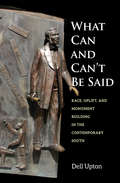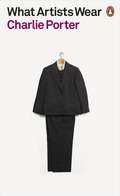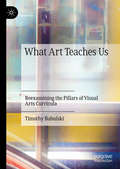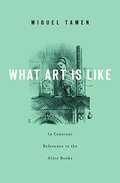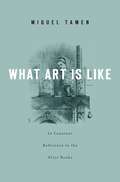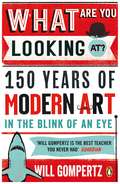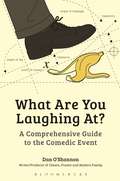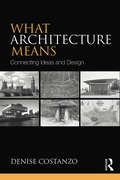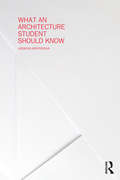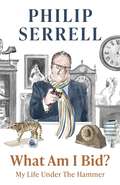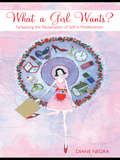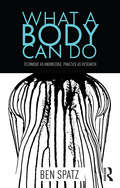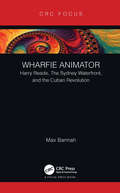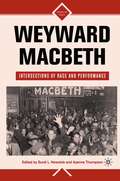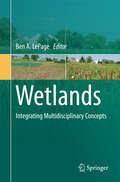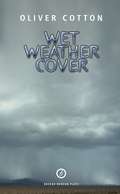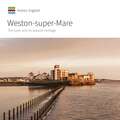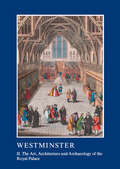- Table View
- List View
What Can and Can't Be Said: Race, Uplift, and Monument Building in the Contemporary South
by Dell UptonAn original study of monuments to the civil rights movement and African American history that have been erected in the U.S. South over the past three decades, this powerful work explores how commemorative structures have been used to assert the presence of black Americans in contemporary Southern society. The author cogently argues that these public memorials, ranging from the famous to the obscure, have emerged from, and speak directly to, the region’s complex racial politics since monument builders have had to contend with widely varied interpretations of the African American past as well as a continuing presence of white supremacist attitudes and monuments.
What Artists Wear
by Charlie Porter'A liberation and a joy, beautifully written and brilliantly thought. What Artists Wear is at once a revelatory account of how art is made and an electrifying investigation into the relationship between clothes and autonomy, freedom and power' Olivia LaingMost of us live our lives in our clothes without realizing their power. But in the hands of artists, garments reveal themselves. They are pure tools of expression, storytelling, resistance and creativity: canvases on which to show who we really are.In What Artists Wear, style luminary Charlie Porter takes us on an invigorating, eye-opening journey through the iconic outfits worn by artists, in the studio, on stage, at work, at home and at play. From Yves Klein's spotless tailoring to the kaleidoscopic costumes of Yayoi Kusama and Cindy Sherman; from Andy Warhol's signature denim to Charlotte Prodger's casualwear, Porter's roving eye picks out the magical, revealing details in the clothes he encounters, weaving together a new way of understanding artists, and of dressing ourselves.Part love letter, part guide to chic, and featuring generous photographic spreads, What Artists Wear is both a manual and a manifesto, a radical, gleeful, inspiration to see the world anew-and find greater pleasure and possibility in the clothes we all wear.
What Art Teaches Us: Reexamining the Pillars of Visual Arts Curricula
by Timothy BabulskiThis book critically examines four areas common to visual arts curricula: the elements of art and principles of design, the canons of human proportions, linear perspective, and RYB color theory. For each, the author presents a compelling case detailing how current art teaching fails students, explores the history of how it came to be part of the discourse, and then proffers cognitivist and holistic alternatives. This book provides a framework for teachers and teacher-candidates to shape how they advocate for intellectual rigor and embodied learning and, importantly, how they can subvert an existing curriculum to better meet the educational needs of their students.
What Art Is Like, In Constant Reference to the Alice Books
by Miguel TamenThis comic, serious inquiry into the nature of art takes its technical vocabulary from Alice’s Adventures in Wonderland and Through the Looking-Glass. It is ridiculous to think of poems, paintings, or films as distinct from other things in the world, including people. Talking about art should be contiguous with talking about other relevant matters.
What Art Is Like, In Constant Reference to the Alice Books
by Miguel TamenThis comic, serious inquiry into the nature of art takes its technical vocabulary from Alice’s Adventures in Wonderland and Through the Looking-Glass. It is ridiculous to think of poems, paintings, or films as distinct from other things in the world, including people. Talking about art should be contiguous with talking about other relevant matters.
What Are You Looking At?: 150 Years of Modern Art in the Blink of an Eye
by Will GompertzWhat Are You Looking At? by Will Gompertz - a wonderfully lively and accessible history of Modern Art by the BBC Arts Editor 'An essential primer not only for art lovers but for art loathers too' **** ExpressWhat is modern art? Why do we either love it or loathe it? And why is it worth so much damn money? Join Will Gompertz on a dazzling tour that will change the way you look at modern art forever. From Monet's water lilies to Van Gogh's sunflowers, from Warhol's soup cans to Hirst's pickled shark, hear the stories behind the masterpieces, meet the artists as they really were, and discover the real point of modern art. You will learn: not all conceptual art is bollocks; Picasso is king (but Cézanne is better); Pollock is no drip; Dali painted with his moustache; a urinal changed the course of art, why your 5-year-old really couldn't do it. Refreshing, irreverent and always straightforward, What Are You Looking At? cuts through the pretentious art speak and asks all the basic questions that you were too afraid to ask. Your next gallery trip is going to be a little less intimidating and a lot more interesting.'Robert Hughes's The Shock of the New redone à la Bill Bryson' ****TelegraphThis book is essential reading for sceptics, art lovers, and the millions of us who visit art galleries every year - and are confused. It will also be enjoyed by readers of The Story of Art by E.H. Gombrich and is a perfect primer to the subject for the student or beginner.Will Gompertz is the BBC Arts Editor and probably the world's first art history stand-up comedian. He was a Director at the Tate Gallery for 7 years. He has a particular interest in modern art and has written about the arts for The Times and the Guardian for over 20 years. In 2009, he wrote and performed a sell-out one-man comedy show about modern art at the Edinburgh Festival. He was recently voted one of the world's top 50 creative thinkers by New York's Creativity Magazine.
What Are You Laughing At?: A Comprehensive Guide to the Comedic Event
by Dan O'ShannonIf you're looking for a book that will teach you how to write comedy, we suggest you keep moving. You still have time to pick up a copy of Writing Big Yucks for Big Bucks before the store closes. However, if you want to understand the bigger picture -- what is comedy, why do we respond to it the way we do -- then you've come to the right place. What Are You Laughing At? presents an entirely new approach to comedy theory. It challenges long-held beliefs and shows how the three main theories of comedy (incongruity, superiority, and relief) are not in conflict; but rather, work as parts of a larger model. There are many examples pulled from the author's own experiences, writing for shows such as Cheers, Frasier, and Modern Family. By the end, you'll have an understanding of just what happens when man meets comedy. It will change the way you hear laughter.
What Architecture Means: Connecting Ideas and Design
by Denise CostanzoWhat Architecture Means introduces you to architecture and allows you to explore the connections between design ideas and values across time, space, and culture. It equips you to play an active and informed role in architecture either as a professional or as a consumer, client, and citizen. By analyzing famous and everyday buildings while presenting and questioning the positions of important architects and theorists, this book will help you to evaluate and decide what qualities, ideas, and values you believe are important in architecture. You'll learn: -How various definitions of "architecture" establish different relationships with all buildings, and even non-buildings;-How buildings express and accommodate ideas of the sacred, the family, and the community;-What an architect is, and what priorities they bring to design and construction;-How an architect’s expertise relates to that of the engineer, and why these are distinct disciplines;-About values like beauty, originality, structural expression, and cultural memory and their purpose in architectural design;-About the interests and ethical values that architects, and architecture, serves and promotes. Topics include sacred spaces, the house, the city, architects and engineers, aesthetics and design, originality and method, technology and form, memory and identity, and power and politics.
What Architecture Means: Connecting Ideas and Design
by Denise CostanzoWhat Architecture Means introduces you to architecture and allows you to explore the connections between design ideas and values across time, space, and culture. It equips you to play an active and informed role in architecture either as a professional or as a consumer, client, and citizen. By analyzing famous and everyday buildings while presenting and questioning the positions of important architects and theorists, this book will help you to evaluate and decide what qualities, ideas, and values you believe are important in architecture. You'll learn: -How various definitions of "architecture" establish different relationships with all buildings, and even non-buildings;-How buildings express and accommodate ideas of the sacred, the family, and the community;-What an architect is, and what priorities they bring to design and construction;-How an architect’s expertise relates to that of the engineer, and why these are distinct disciplines;-About values like beauty, originality, structural expression, and cultural memory and their purpose in architectural design;-About the interests and ethical values that architects, and architecture, serves and promotes. Topics include sacred spaces, the house, the city, architects and engineers, aesthetics and design, originality and method, technology and form, memory and identity, and power and politics.
What an Architecture Student Should Know
by Jadwiga KrupinskaIt's not just you. Every architecture student is initially confused by architecture school - an education so different that it doesn't compare to anything else. A student’s joy at being chosen in stiff competition with many other applicants can turn to doubt when he or she struggles to understand the logic of the specific teaching method. Testimony from several schools of design and architecture in different countries indicates that many students feel disoriented and uncertain. This book will help you understand and be aware of: Specific working methods at architecture schools and in the critique process, so you'll feel oriented and confident. How to cope with uncertainty in the design process. How to develop the ability to synthesize the complexity of architecture in terms of function, durability, and beauty. This book is about how architects learn to cope with uncertainty and strive to master complexity. Special attention is given to criticism, which is an essential part of the design process. The author, a recipient of several educational awards, has written this book for architecture students and teachers, to describe how each student can adopt the architect's working method. Key concepts are defined throughout and references at the end of each chapter will point you to further reading so you can delve into topics you find particularly interesting. Jadwiga Krupinska is professor emerita at the School of Architecture of the Royal Institute of Technology (KTH) in Stockholm, Sweden.
What an Architecture Student Should Know
by Jadwiga KrupinskaIt's not just you. Every architecture student is initially confused by architecture school - an education so different that it doesn't compare to anything else. A student’s joy at being chosen in stiff competition with many other applicants can turn to doubt when he or she struggles to understand the logic of the specific teaching method. Testimony from several schools of design and architecture in different countries indicates that many students feel disoriented and uncertain. This book will help you understand and be aware of: Specific working methods at architecture schools and in the critique process, so you'll feel oriented and confident. How to cope with uncertainty in the design process. How to develop the ability to synthesize the complexity of architecture in terms of function, durability, and beauty. This book is about how architects learn to cope with uncertainty and strive to master complexity. Special attention is given to criticism, which is an essential part of the design process. The author, a recipient of several educational awards, has written this book for architecture students and teachers, to describe how each student can adopt the architect's working method. Key concepts are defined throughout and references at the end of each chapter will point you to further reading so you can delve into topics you find particularly interesting. Jadwiga Krupinska is professor emerita at the School of Architecture of the Royal Institute of Technology (KTH) in Stockholm, Sweden.
What Am I Bid?
by Philip SerrellWhen Philip Serrell - now well known for his television appearances - gave up teaching to become a professional auctioneer, he thought he was embarking on a sensible and safe career . . . a quiet life in the country with no surprises. How wrong he was. In WHAT AM I BID? he tells of life after the events he described in AN AUCTIONEER'S LOT (2006) and SOLD TO THE MAN WITH THE TIN LEG (2007), to bring his story up to date. From dodgy cars to fakes in the saleroom; angry livestock, mangled silverware and tortuous - not to mention muddy - experiences in local markets and farm sales, Philip has been there, done that and got the hoofprints on his suit to prove it.
What a Girl Wants?: Fantasizing the Reclamation of Self in Postfeminism
by Diane NegraFrom domestic goddess to desperate housewife, What a Girl Wants? explores the importance and centrality of postfeminism in contemporary popular culture. Focusing on a diverse range of media forms, including film, TV, advertising and journalism, Diane Negra holds up a mirror to the contemporary female subject who finds herself centralized in commodity culture to a largely unprecedented degree at a time when Hollywood romantic comedies, chick-lit, and female-centred primetime TV dramas all compete for her attention and spending power. The models and anti-role models analyzed in the book include the chick flick heroines of princess films, makeover movies and time travel dramas, celebrity brides and bravura mothers, ‘Runaway Bride’ sensation Jennifer Wilbanks, the sex workers, flight attendants and nannies who maintain such a high profile in postfeminist popular culture, the authors of postfeminist panic literature on dating, marriage and motherhood and the domestic gurus who propound luxury lifestyling as a showcase for the ‘achieved’ female self.
What a Girl Wants?: Fantasizing the Reclamation of Self in Postfeminism
by Diane NegraFrom domestic goddess to desperate housewife, What a Girl Wants? explores the importance and centrality of postfeminism in contemporary popular culture. Focusing on a diverse range of media forms, including film, TV, advertising and journalism, Diane Negra holds up a mirror to the contemporary female subject who finds herself centralized in commodity culture to a largely unprecedented degree at a time when Hollywood romantic comedies, chick-lit, and female-centred primetime TV dramas all compete for her attention and spending power. The models and anti-role models analyzed in the book include the chick flick heroines of princess films, makeover movies and time travel dramas, celebrity brides and bravura mothers, ‘Runaway Bride’ sensation Jennifer Wilbanks, the sex workers, flight attendants and nannies who maintain such a high profile in postfeminist popular culture, the authors of postfeminist panic literature on dating, marriage and motherhood and the domestic gurus who propound luxury lifestyling as a showcase for the ‘achieved’ female self.
What a Body Can Do
by Ben SpatzIn What a Body Can Do, Ben Spatz develops, for the first time, a rigorous theory of embodied technique as knowledge. He argues that viewing technique as both training and research has much to offer current debates over the role of practice in the university, including the debates around "practice as research." Drawing on critical perspectives from the sociology of knowledge, phenomenology, dance studies, enactive cognition, and other areas, Spatz argues that technique is a major area of historical and ongoing research in physical culture, performing arts, and everyday life.
What a Body Can Do
by Ben SpatzIn What a Body Can Do, Ben Spatz develops, for the first time, a rigorous theory of embodied technique as knowledge. He argues that viewing technique as both training and research has much to offer current debates over the role of practice in the university, including the debates around "practice as research." Drawing on critical perspectives from the sociology of knowledge, phenomenology, dance studies, enactive cognition, and other areas, Spatz argues that technique is a major area of historical and ongoing research in physical culture, performing arts, and everyday life.
Wharfie Animator: Harry Reade, The Sydney Waterfront, and the Cuban Revolution
by Max BannahThis book examines the life of the Australian artist Harry Reade (1927–1998) and his largely overlooked contribution to animation. It constitutes a biography of Reade, tracing his life from his birth to his period of involvement with animation between 1956 and 1969. It explores the forces that shaped Reade and chronicles his experiences as a child, his early working life, the influence of left-wing ideology on his creative development, his introduction to animation through the small but radical Waterside Workers’ Federation Film Unit (WWFFU), and the influence he had on the development of Cuban animation as an educational tool of the Revolution. Key Features The text offers an alternative framework for considering the political, social, and cultural themes that characterised 1950s Australia and 1960s Cuba. A rare look into the cultural heritage of labor organizations and the populist power of animation to stimulate radical social consciousness. The book also crosses a range of intellectual disciplines, including Animation Studies, Art History, Cinema Studies, and the Social and Political Histories of Australia and Cuba. Max Bannah lives on Queensland’s Sunshine Coast. Between 1976 and 2010, he worked in Brisbane as an animator producing television commercials, short films, and cartoon graphics. He also lectured in Animation History and Practice and Drawing for Animation at the Queensland University of Technology where, in 2007, he completed his Masters by Research thesis, "A Cause for Animation: Harry Reade and the Cuban Revolution."
Wharfie Animator: Harry Reade, The Sydney Waterfront, and the Cuban Revolution
by Max BannahThis book examines the life of the Australian artist Harry Reade (1927–1998) and his largely overlooked contribution to animation. It constitutes a biography of Reade, tracing his life from his birth to his period of involvement with animation between 1956 and 1969. It explores the forces that shaped Reade and chronicles his experiences as a child, his early working life, the influence of left-wing ideology on his creative development, his introduction to animation through the small but radical Waterside Workers’ Federation Film Unit (WWFFU), and the influence he had on the development of Cuban animation as an educational tool of the Revolution. Key Features The text offers an alternative framework for considering the political, social, and cultural themes that characterised 1950s Australia and 1960s Cuba. A rare look into the cultural heritage of labor organizations and the populist power of animation to stimulate radical social consciousness. The book also crosses a range of intellectual disciplines, including Animation Studies, Art History, Cinema Studies, and the Social and Political Histories of Australia and Cuba. Max Bannah lives on Queensland’s Sunshine Coast. Between 1976 and 2010, he worked in Brisbane as an animator producing television commercials, short films, and cartoon graphics. He also lectured in Animation History and Practice and Drawing for Animation at the Queensland University of Technology where, in 2007, he completed his Masters by Research thesis, "A Cause for Animation: Harry Reade and the Cuban Revolution."
Weyward Macbeth: Intersections of Race and Performance (Signs of Race)
by Ayanna Thompson S. NewstokWeyward Macbeth, a volume of entirely new essays, provides innovative, interdisciplinary approaches to the various ways Shakespeare's 'Macbeth' has been adapted and appropriated within the context of American racial constructions. Comprehensive in its scope, this collection addresses the enduringly fraught history of 'Macbeth' in the United States, from its appearance as the first Shakespearean play documented in the American colonies to a proposed Hollywood film version with a black diasporic cast. Over two dozen contributions explore 'Macbeth's' haunting presence in American drama, poetry, film, music, history, politics, acting, and directing — all through the intersections of race and performance.
Wetlands: Integrating Multidisciplinary Concepts
by Ben A. LePageThe science of wetlands and our understanding of these complex ecosystems have improved considerably. The emergence of multidisciplinary strategies is providing new opportunities and innovative approaches to address issues such as climate change and coastal protection. This book, with contributions from 19 specialists from academia, government, and industry, provides a trans-disciplinary approach to the understanding wetlands science, drawing together a wide range of expertise. Topics covered include the physical aspects that shape different wetlands around the world, as well as wetlands ecology, regulation, policy, and related social and economic issues.Featuring contributions from some of the world’s leading wetlands researchers and practitioners, this book provides an invaluable resource for undergraduate and post-graduate training in all aspects of wetlands management, conservation, and construction. It is also a useful auxiliary text for researchers working across disciplines in fields such as wetlands science, law, landscape architecture, environmental engineering, conservation ecology, and related disciplines.
Wet Weather Cover (Oberon Modern Plays)
by Oliver CottonOliver Cotton is a British stage and screen actor, well known for his work on stage, TV and film. In this, his first published stage play, Cotton draws on his own experience as he presents two actors - one English, the other American - marooned on location miles from anywhere, confined in their tiny dressing space by the unrelenting rain. Growing increasingly frustrated, they engage in a magnificently sustained verbal duel, a love-hate clash of cultures, countries and personalities.
Weston-super-Mare: The town and its seaside heritage (Informed Conservation)
by Allan Brodie Johanna Roethe Kate Hudson-McAulayTwo centuries ago Weston-super-Mare was a small, rarely visited village but its location alongside the Severn Estuary soon made it a convenient bathing place for the wealthy inhabitants of Bristol and Bath. Once the railway arrived in 1841, the handful of brave sea bathers became thousands of day trippers in search of fun and sunshine. Weston also became popular with excursionists and holidaymakers arriving by steamer from South Wales. To cater for all these visitors, the small entertainment and bathing facilities enjoyed by the wealthy Georgian elite were replaced by larger, more popular facilities, including two piers, Winter Gardens, a large swimming bath and a substantial open-air pool. Weston is not only a busy seaside resort, but a popular place to live. During the 19th century its population rose from around 100 to almost 20,000 and its handful of small, fisherman’s cottages became a sea of terraces, crescents and villas constructed using the local stone. A distinctive type of villa emerged in Weston, different from those found at either of its larger neighbours. This was in large part due to Hans Fowler Price, the town’s leading architect for more than half a century from 1860 until his death in 1912. The book celebrates the complex history and colourful heritage of the town. It also looks to the future to examine how its 200-year story might contribute to a prosperous future.
Weston Park Main War Memorial (UEB contracted)
by RnibThe main war memorial is made from a tapered square column of granite, approximately 9 metres in height, that sits on a wider plinth that is surrounded on all sides by four steps. Four short square pillars edge the side of the steps. Two life-size bronze statues of soldiers dressed in full military uniform, including tin hat with one carrying a rifle and the other a pistol, are positioned one on either side of the wider plinth. Although both are dressed ready for battle they are portrayed standing in a non-combat pose looking thoughtfully out across the park landscape. There are several raised bands of simple decoration that surround the column - behind and slightly above the soldiers and just below the domed top of the column. A bronze statue of the Roman winged goddess Victory stands on the domed top of the column. She is standing on tiptoes with her right leg held slightly out behind her. Her back is arched with her head looking upwards and her wings outstretched behind her. She is holding a victor's wreath high up above her head with her right arm and holds a sheath of corn down by her side with the other. She is wearing a loosely draped dress that clings to her figure. The tactile images gives a simplified overview of the main memorial showing one of the four sides with the soldier carrying the rifle and a side view of the Roman goddess. The main war memorial was erected in the park in 1922. The soldiers were students of the Sheffield College of Art posing for the sculptor.
Westminster Part II: The Art, Architecture and Archaeology of the Royal Palace (The British Archaeological Association Conference Transactions)
by Warwick Rodwell Tim Tatton-BrownWestminster came into existence in the later Anglo-Saxon period, and by the mid-11th century, when Edward the Confessor’s great new abbey was built, it was a major royal centre two miles south-west of the City of London. Within a century or so, it had become the principal seat of government in England, and this series of twenty-eight papers covers new research on the topography, buildings, art-history, architecture and archaeology of Westminster’s two great establishments — Abbey and Palace. Part I begins with studies of the topography of the area, an account of its Roman-period finds and an historiographical overview of the archaeology of the Abbey. Edward the Confessor’s enigmatic church plan is discussed and the evidence for later Romanesque structures is assembled for the first time. Five papers examine aspects of Henry III’s vast new Abbey church and its decoration. A further four cover aspects of the later medieval period, coronation, and Sir George Gilbert Scott’s impact as the Abbey’s greatest Surveyor of the Fabric. A pair of papers examines the development of the northern precinct of the Abbey, around St Margaret’s Church, and the remarkable buildings of Westminster School, created within the remains of the monastery in the 17th and 18th centuries. Part II part deals with the Palace of Westminster and its wider topography between the late 11th century and the devastating fire of 1834 that largely destroyed the medieval palace. William Rufus’s enormous hall and its famous roofs are completely reassessed, and comparisons discussed between this structure and the great hall at Caen. Other essays reconsider Henry III’s palace, St Stephen’s chapel, the king’s great chamber (the ‘Painted Chamber’) and the enigmatic Jewel Tower. The final papers examine the meeting places of Parliament and the living accommodation of the MPs who attended it, the topography of the Palace between the Reformation and the fire of 1834, and the building of the New Palace which is better known today as the Houses of Parliament.
Westminster Part II: The Art, Architecture and Archaeology of the Royal Palace (The British Archaeological Association Conference Transactions)
by Warwick Rodwell; Tim Tatton-BrownWestminster came into existence in the later Anglo-Saxon period, and by the mid-11th century, when Edward the Confessor’s great new abbey was built, it was a major royal centre two miles south-west of the City of London. Within a century or so, it had become the principal seat of government in England, and this series of twenty-eight papers covers new research on the topography, buildings, art-history, architecture and archaeology of Westminster’s two great establishments — Abbey and Palace. Part I begins with studies of the topography of the area, an account of its Roman-period finds and an historiographical overview of the archaeology of the Abbey. Edward the Confessor’s enigmatic church plan is discussed and the evidence for later Romanesque structures is assembled for the first time. Five papers examine aspects of Henry III’s vast new Abbey church and its decoration. A further four cover aspects of the later medieval period, coronation, and Sir George Gilbert Scott’s impact as the Abbey’s greatest Surveyor of the Fabric. A pair of papers examines the development of the northern precinct of the Abbey, around St Margaret’s Church, and the remarkable buildings of Westminster School, created within the remains of the monastery in the 17th and 18th centuries. Part II part deals with the Palace of Westminster and its wider topography between the late 11th century and the devastating fire of 1834 that largely destroyed the medieval palace. William Rufus’s enormous hall and its famous roofs are completely reassessed, and comparisons discussed between this structure and the great hall at Caen. Other essays reconsider Henry III’s palace, St Stephen’s chapel, the king’s great chamber (the ‘Painted Chamber’) and the enigmatic Jewel Tower. The final papers examine the meeting places of Parliament and the living accommodation of the MPs who attended it, the topography of the Palace between the Reformation and the fire of 1834, and the building of the New Palace which is better known today as the Houses of Parliament.
